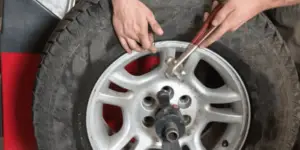This is a common question. Here we’ll examine the benefits and potential cost of having your rear tires balanced along with symptoms that a weight may have fallen off. We’ll also look at what other parts can fail if they are not balanced right.
Briefly though:
Your rear tires should be balanced. Most reputable tire shops wouldn’t think of not balancing them. Unbalanced rear tires can result in vibration and speed up the failure of suspension parts.
What Happens If You Don’t Balance The Rear Tires?
Unless the tire has been on a balancing machine, no one will know if it’s balanced or not.
There are three consequences of having unbalanced rear tires.
They are:
Vibration at Higher Speeds
Some people wrongly believe that they don’t have to get the rear tires balanced unless their car is rear-wheel drive. The argument is that it’s only the tires and wheels providing the power that needs to rotate completely in sync.
Although it’s true that you’re more likely to feel a vibration from the wheels that are providing the power, it’s not limited to that. Non drive rear wheels will still vibrate. The higher the speed, the more noticeable shaking will be.
Vibration from the rear tires of luxury cars is more noticeable due to the tires being lower profile and the car having more taut suspension.
Added Stress To Transmission and Suspension.
Often the weight distribution is out by less than 5g, and no weights are needed. Any difference over 5g will require weights to be added, though.
As a car tire rotates around 700 times in a mile, you can see how even a slight shake will put cumulative wear on the other connecting parts.
Uneven Rear Tire Wear
There are more than a few reasons why tires wear unevenly, but if you’ve had to replace suspension coil springs and have vibration, as mentioned above, a badly balanced tire is a real possibility.
Will A Tire Shop Always Balance The Rear Tires?
Some shady tire shops may quote without the costs of the weights to get you through the door. Once in, they’ll offer it as an optional extra. This is unusual, though.
All the larger tire shop chains include the cost of a rear wheel balance in their standard prices.

If you visit one to get your winter tires put on the same rims as your summer tires, they may charge you for this. Always best to ask before taking your car there.
If you always have to get your tires balanced every six months when you change your tires over, get a second set of rims for winter tires.
This saves the need to pay for balancing every time you change over the tires. This may be more expensive to start – although used car rims are very cheap – If you plan on keeping the car for more than a few years and don’t drive thousands of miles a year, it works out cheaper both in terms of money and time spent back and forth to the tire shop.
Rear Vibration Has Just Started
Weights do fall off. If you’ve only just started to experience shaking from the rear wheels, a dislodged weight could be the cause.
On alloy wheels, the weights are often stuck on with adhesive tape, or the actual weight itself comes in an adhesive strip. The tire shop sticks on the correct amount of bars to balance them. They normally come in 5g bar strips.
Many visitors also read this article: Wheel Alignment Vs. Tire Balancing
Where Are The Weights Added?
This depends on where the weight is needed. It might be that the tire requires weight on the outside; therefore, that’s where the bar will often go though the inside will require the weight. Unlike a front wheel, it can be difficult to see around the back of a rear wheel; you can’t turn the rear left or right to get a good look.

If the vibration has only started recently, slide under the car and look for a lighter patch on the alloy, which could indicate a bar has fallen off and the exposed alloy hasn’t gotten as dirty as the rest of the alloy yet. If you notice a lighter patch, buy a set of bars; they’re cheap, and stick a new one on where the old one has fallen off.
If you don’t fancy getting dirty under the car, a tire shop will charge about $10 to rebalance one tire for you.
Why Do Weight Bars Fall Off A Wheel?
Alloy weights are notorious for falling off. Although the adhesive is heavy duty, the weight is put under a lot of strain. This includes rotating up to 70 mph. Absorbing water and then freezing and thawing again. This can loosen the adhesive pad. Dirt and mud can get underneath the pad too.
Steel wheels have the option of ‘knock-on’ weights. Alloy wheels aren’t able to have these as it would damage the weaker aluminum or magnesium they are made from.
Knock-on weights are hammered into place on the bead or lip of the wheel where needed and are much less likely to fall off.
In conclusion
All four wheels must be balanced; otherwise, your safety will be put at risk. Your car will have a bumpy ride and your tires will wear unevenly and need to be changed sooner than necessary.





![How Long Do New Tires Take To Put On? [ANSWERED] Torque-wrench-tire](https://carzaza.com/wp-content/uploads/2023/12/Torque-wrench-tire-300x150.png)







